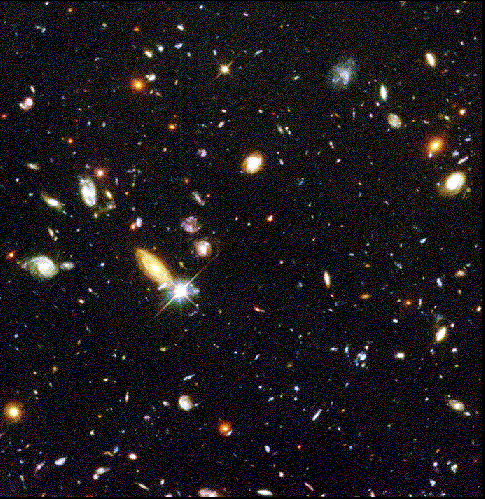 the Sun would be roughly four trillion times brighter than an
identical star 30 light years away.
the Sun would be roughly four trillion times brighter than an
identical star 30 light years away.

 One principal characteristic of any star seen in a normal optical
telescope is its brightness (or luminosity). It is clear that the Sun
is far brighter than any other star in the sky, yet we stated above
that as stars go it is rather average. This tells us that when
considering how bright an object is we must take into account how
close it is to us. A car with its headlights on full beam is not
particularly annoying until it gets to within about 300m of us.
Similarly, the distance a luminous star is from us has an important
bearing on how bright we perceive it to be. The Sun being so close
appears to be far brighter than any star seen in the night sky.
One principal characteristic of any star seen in a normal optical
telescope is its brightness (or luminosity). It is clear that the Sun
is far brighter than any other star in the sky, yet we stated above
that as stars go it is rather average. This tells us that when
considering how bright an object is we must take into account how
close it is to us. A car with its headlights on full beam is not
particularly annoying until it gets to within about 300m of us.
Similarly, the distance a luminous star is from us has an important
bearing on how bright we perceive it to be. The Sun being so close
appears to be far brighter than any star seen in the night sky.
Astronomers define two types of brightness when referring to the light
being emitted from a star or other
celestial object.
The apparent brightness is how bright we perceive the star in relation to
other stars. In the 2nd century BC the Greek astronomer, Hipparchus,
categorized all naked eye stars into six brightness
classes, numbered 1 through 6. A star of brightness 1 corresponds to the
brightest visible and a star of brightness 6 is just discernible to
the naked eye. Despite the subjectivity of this system it has
remained in use to the present day. In terms of apparent brightness,
 the Sun would be roughly four trillion times brighter than an
identical star 30 light years away.
the Sun would be roughly four trillion times brighter than an
identical star 30 light years away.
A more objective measure of a
star's brightness is obtained when we correct for distance and define
the intrinsic brightness of a star. This is
done by allowing for the different distances of the stars from the earth.
This is possible
because we know exactly how the light from a given object is diluted
as it spreads out in space. When each star is assigned an absolute
brightness, a direct and fair comparison between different stars is
possible. Under this system of measurement the Sun has an absolute
brightness equivalent to 4.6 on Hipparchus' naked eye scale. This is
not particularly impressive in stellar terms but does constitute
4 x 10^26 Watts of energy continually bathing the earth. At this rate
of energy generation the Sun is expected to last for 10,000 million
years.
